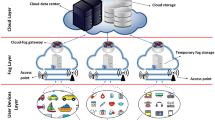Abstract
Cloud computing is a mature technology that provides a huge leap in elastic computation, and new development trends are shaped to compliment the cloud computing paradigm. Cisco recently introduced the concept of Fog Computing to enable applications on billions of devices that are already connected and form the Internet of Things at the edge of the network. With the view point that the fog computing paradigm will be the future of computing technology, we look at its strong characteristics and propose a novel approach to enable a new kind of service called Offload As A Service (OaaS). Offload computation has been an active research area for many years and provides the capability to extend mobile resources limitations in terms of CPU, GPU, memory, storage and battery energy. Fog computing paradigm is a good synergy for offload computation technology with its low delay and close proximity features. To realize the enabling of OaaS in a fog computing environment, we propose a novel framework for communication and an offloading mechanism between different layers of the fog infrastructure, using matching algorithm to handle the fair mapping between users and service providers. Simulation results are provided to validate the effectiveness of our proposal. Simulation results of our work have shown great potential and value based on the prototype implementation, especially in the running time of tasks, which was reduced significantly with improvements of up to 37 and \(12\%\) observed for photos offloaded to “PC” and “Odroid”, respectively, compared to the local running time on the user device.
















Similar content being viewed by others
References
Rimal BP, Choi Eunmi, Lumb I (2009) A taxonomy and survey of cloud computing systems. INC, IMS and IDC, 2009. NCM ’09. In: Fifth international joint conference on, vol., no., pp 44,51, 25–27
Gubbi J et al (2013) Internet of things (IoT): a vision, architectural elements, and future directions. Future Gener Comput Syst 29(7):1645–1660
Bonomi F (2011) Connected vehicles, the Internet of things, and fog computing. The Eighth ACM Int. Workshop on Vehicular Inter Networking VANET, Las Vegas, USA
Bahtovski A, Marjan G (2014) Cloudlet challenges. Proced Eng 69:704–711
Bonomi F, Milito R, Zhu J, Addepalli S (2012) Fog computing and its role in the internet of things. In: 1st ACM MCC Workshop on Mobile Cloud Computing, 13–16
http://newsroom.cisco.com/release/1334100, 29 Jan 2014
Cuervo E, Balasubramanian A, Cho D, Wolman A, Saroiu S, Chandra R, Bahl P (2010) MAUI: making smartphones last longer with code offload. In: International conference
Chun B-G, Ihm S, Maniatis P, Naik M, Patti A (2011) CloneCloud: elastic execution between mobile device and cloud. In: Proceedings of the sixth conference on Computer systems (EuroSys ’11). ACM, New York, NY, USA, 301–314
Kumar K, Liu J, Lu Y-H, Bhargava B (2013) A survey of computation offloading for mobile systems. Mob. Netw. Appl. 18(1):129–140
Bertino E et al (2001) Author-: a java-based system for XML data protection. Data and application security. Springer, New York, pp 15–26
oseph AD, de Lespinasse AF, Tauber JA, Gifford DK, Kaashoek MF (1995) Rover: a toolkit for mobile information access. In: ACM symposium on operating systems principles, pp 156–171
Adams K, Agesen O (2006) A comparison of software and hardware techniques for x86 virtualization. In: International conference on architectural support for programming languages and operating systems, pp 2–13
Barham P, Dragovic B, Fraser K, Hand S, Harris T, Ho A, Neugebauer R, Pratt I, Warfield A (2003) Xen and the art of virtualization. In: ACM symposium on operating systems principles, pp 164–177
Rosenblum M, Garfinkel T (2005) Virtual machine monitors: current technology and future trends. IEEE Comput 38(5):39–47
http://www.nobelprize.org/nobel_prizes/economic-sciences/laureates/2012/press.html
Flores H, Hui Pan, Tarkoma S, Yong Li, Srirama S, Buyya R (2015) Mobile code offloading: from concept to practice and beyond. Commun Mag IEEE 53(3):80–88
Gandhewar N, Sheikh R (2010) Google android: an emerging software platform for mobile devices. Int J Comput Sci Eng 1(1):12–17
Asadi A, Mancuso V (2013) Wifi direct and lte d2d in action. Wireless Days (WD), 2013 IFIP. IEEE
http://www.hardkernel.com/main/products/prdt_info.php?g_code=G140448267127
Roth AE (2008) Deferred acceptance algorithms: history, theory, practice, and open questions. Int J Game Theory 36(3–4):537–569
Roth Alvin E (1985) The college admissions problem is not equivalent to the marriage problem. J Econ Theory 36(2):277–288, ISSN 0022-0531
Gusfield D, Irving RW (1989) The stable marriage problem: structure and algorithms. MIT Press, Boston
Acknowledgements
This work was supported by Institute for Information & communications Technology Promotion (IITP) grant funded by the Korea government (MSIP) (B0190-16-2017, Resilient/Fault-Tolerant Autonomic Networking Based on Physicality, Relationship and Service Semantic of IoT Devices).
Author information
Authors and Affiliations
Corresponding author
Rights and permissions
About this article
Cite this article
Tran, D.H., Tran, N.H., Pham, C. et al. OaaS: offload as a service in fog networks. Computing 99, 1081–1104 (2017). https://doi.org/10.1007/s00607-017-0551-z
Received:
Accepted:
Published:
Issue Date:
DOI: https://doi.org/10.1007/s00607-017-0551-z




